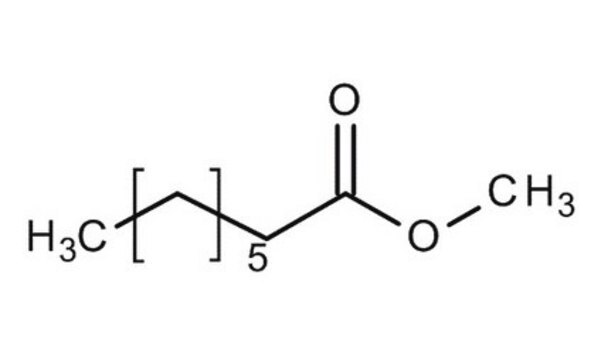299030
Methyl decanoate
99%
Synonym(s):
Capric acid methyl ester, Decanoic acid methyl ester, Methyl caprate
About This Item
Recommended Products
Quality Level
assay
99%
form
liquid
refractive index
n20/D 1.425 (lit.)
bp
108 °C/10 mmHg
224 °C (lit.)
mp
−14-−11 °C (lit.)
solubility
chloroform: soluble 100 mg/mL, clear
density
0.871 g/mL at 20 °C (lit.)
SMILES string
CCCCCCCCCC(=O)OC
InChI
1S/C11H22O2/c1-3-4-5-6-7-8-9-10-11(12)13-2/h3-10H2,1-2H3
InChI key
YRHYCMZPEVDGFQ-UHFFFAOYSA-N
Looking for similar products? Visit Product Comparison Guide
Related Categories
General description
Application
- Application of mist to fingermark detection: Misting with high-boiling-point liquid containing p-dimethylaminocinnamaldehyde and cyanoacrylate.: This article explored the use of high-boiling-point liquids, including methyl decanoate, in misting techniques for forensic fingermark detection. (Takatsu et al., 2023).
signalword
Warning
hcodes
pcodes
Hazard Classifications
Aquatic Acute 1 - Aquatic Chronic 2
Storage Class
10 - Combustible liquids
wgk_germany
WGK 1
flash_point_f
230.9 °F - Pensky-Martens closed cup
flash_point_c
110.5 °C - Pensky-Martens closed cup
ppe
Eyeshields, Gloves, type ABEK (EN14387) respirator filter
Certificates of Analysis (COA)
Search for Certificates of Analysis (COA) by entering the products Lot/Batch Number. Lot and Batch Numbers can be found on a product’s label following the words ‘Lot’ or ‘Batch’.
Already Own This Product?
Find documentation for the products that you have recently purchased in the Document Library.
Customers Also Viewed
Our team of scientists has experience in all areas of research including Life Science, Material Science, Chemical Synthesis, Chromatography, Analytical and many others.
Contact Technical Service










